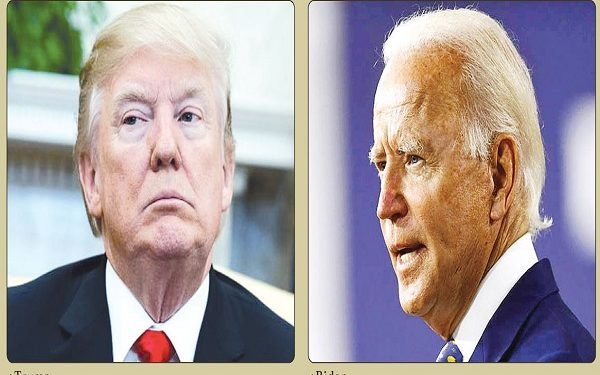President Donald Trump and Democratic challenger Joe Biden had one last chance to make their case to voters in critical battleground states on Monday – the final full day of a campaign that laid bare their dramatically different visions for tackling the nation’s pressing problems and for the office of the presidency itself.
The candidates are seeking to lead a nation at a crossroads, gripped by a historic pandemic that is raging anew in nearly every corner of the country and a reckoning over race. More than 97.6 million people have already voted and it could take longer than usual for elections officials to process the historic surge in early and mail-in ballots.
Trump, Biden insist they will be victorious
Both campaigns insist they have a pathway to victory, though Biden’s options for picking up the required 270 Electoral College votes are more plentiful. Trump is banking on a surge of enthusiasm from his most loyal supporters while also threatening legal action to stop vote counting in some crucial states, including Pennsylvania.
The Republican president’s final day has him sprinting through five rallies, from North Carolina to Wisconsin. Biden, meanwhile, was devoting most of his time to Pennsylvania, where a win would leave Trump with an exceedingly narrow path. Biden was also dipping into Ohio, a show of confidence in a state where Trump won by eight percentage points four years ago.
Heading into the closing 24 hours, Trump and Biden each painted the other as unfit for office and described the next four years in near apocalyptic terms if the other were to win.
“The Biden plan will turn America into a prison state locking you down while letting the far-left rioters roam free to loot and burn,” Trump thundered Sunday at a rally in Iowa, one of the five he held in battleground states.
e,” Biden said in Philadelphia, the biggest city in a state that could decide the presidency.
COVID-19 reaches new peak
As the candidates close out the campaign, the pandemic, which has killed more than 231,000 people nationwide and caused nearly 20 million to lose jobs, reached a new peak in infection rates, threatening yet another blow to lives and livelihoods of voters.
The election caps an extraordinary year that began with Trump’s impeachment, the near collapse of Biden’s candidacy during the crowded Democratic primary and then was fully reshaped by the coronavirus outbreak.
Republican Party threatens litigation
In the starkest terms yet, Trump on Sunday threatened litigation to stop the tabulation of ballots arriving after Election Day. As soon as polls closed in battlegrounds such as Pennsylvania, Trump said, “we’re going in with our lawyers.”
It was unclear precisely what Trump meant. There is already an appeal pending at the Supreme Court over the counting of absentee ballots in Pennsylvania that are received in the mail in the three days after the election.
The state’s top court ordered the extension and the Supreme Court refused to block it, though conservative justices expressed interest in taking up the propriety of the three added days after the election. Those ballots are being kept separate in case the litigation goes forward. The issue could assume enormous importance if the late-arriving ballots could tip the outcome.
Under the shadow of possible legal battles, Pennsylvania loomed as most important battleground.
For Biden, who lives in neighbouring Delaware, Pennsylvania has long been the focus of his campaign, a bulwark to block Trump from securing the electoral votes needed for reelection. Both he and his running mate, Senator Kamala Harris, and their spouses will crisscross the state Monday — hoping to deliver a knockout blow to Trump without potential Pennsylvania legal challenges.
Trump once led comfortably in Ohio. Biden’s trip there comes after his ticket’s pushes into other formerly reliable Trump strongholds including Georgia, where the Democrats’ most popular surrogate, former President Barack Obama, was campaigning yesterday.
Trump urges voters in key swing states to vote early
Barely some fewer hours to presidential election in the U.S., Trump urged voters in some key states to get their ballots in early.
“As long as I’m in office, NEBRASKA, MICHIGAN, MINNESOTA and OHIO will bounce back Bigger and Better than ever before! Early Vote polls close today in these Great states.
“We need YOU to get out and VOTE! Together, we’ll MAKE AMERICA GREAT AGAIN!!” Trump tweeted on Monday.
Michigan, Minnesota and Ohio are so-called swing states and the results in these key battleground areas could sway the election results.
Polls for in-person voting are due to open today but a little more than 94 million people around the country have already voted early, an official said.
The voting of 94 million was according to the U.S. Elections Project, a turnout-tracking database created by a professor from the University of Florida, who specialises in U.S. elections.
This unprecedented number of early votes is due in large part to concerns about the coronavirus pandemic and the need to maintain social distancing on election day.
Some U.S. states, such as Florida and Louisiana, ended in-person early voting in the week before the election.
But a handful of states have opted to end in-person early voting on the day before the election.
Mail-in ballots must be post-marked and sent by the day of the election, but many states will count ballots that arrive after election day as long as they are correctly post-marked, meaning that the election results may not be immediately apparent today evening.
Biden still ahead in national opinion polls
Biden leads Trump by 10 percentage points in Wisconsin and Michigan, and the presidential nominee is ahead by seven points in Pennsylvania. Biden has led Trump in all three states in every Reuters/Ipsos weekly poll that began in mid-September, and his leads have ticked higher in the each state over the past two weeks.
Reuters/Ipsos is polling likely voters in six states – Wisconsin, Pennsylvania, Michigan, North Carolina, Florida and Arizona – that will play critical roles in deciding whether Trump wins a second term in office or if Biden ousts him.
Four years after Donald Trump’s surprise presidential victory roiled markets, investors are prepared for short-term trading turmoil and major long-term policy shifts, on the eve of today’s U.S. election.
Investors could confront dramatically different paths for the country on taxes, government spending, trade and regulation depending on who wins the White House, the Republican Trump or Democratic former Vice President Joe Biden.
Biden is ahead in national opinion polls, but races are tight in battleground states that could tip the election to Trump. And perhaps the outcome most likely to shake markets – at least in the near term – is no immediate outcome at all.
“At this point, markets fear a contested election,” said Kristina Hooper, chief global market strategist at Invesco. “Anything other than a contested election, a decisive victory in particular, would be good news for stocks.”









